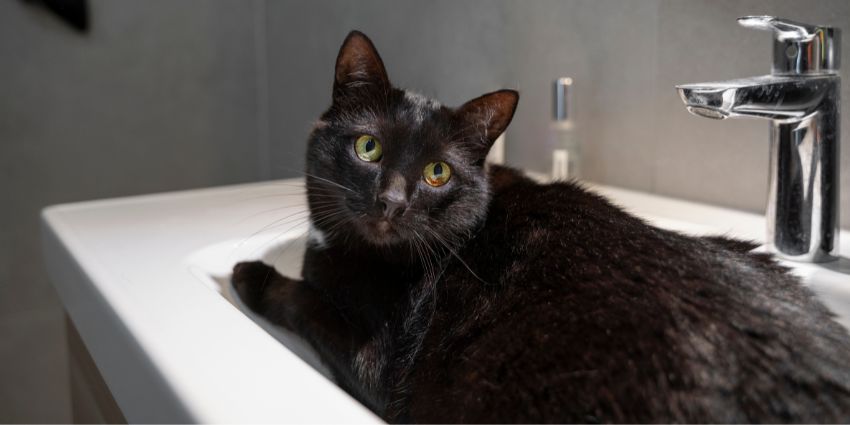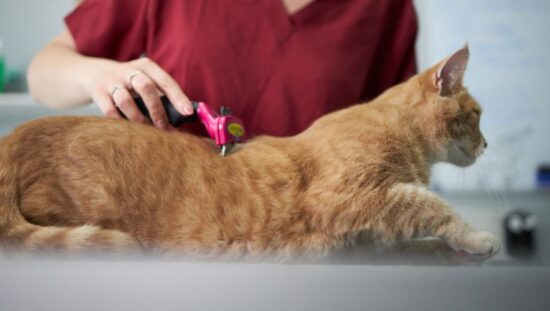Bathing your cat for the first time seems like a difficult task, but with the right approach and some essential tips, you can make the experience stress-free for both you and your cat.
This guide covers everything you need to know, from preparation to post-bath pampering, to ensure a successful bathing session. You can follow these steps regardless of whether your cat loves water or isn’t a fan of baths. So, let’s dive in and learn the essentials of bathing your cat for the first time!

Why Bathe Your Cat?
Bathing your cat might not be something you do every day, because cats are pretty independent when it comes to grooming, but there are situations where a bath is necessary to keep them clean and healthy.
One big reason to bathe your cat is to remove dirt and oils from their fur. Even though cats spend a lot of time grooming themselves, sometimes they can’t get rid of all the dirt. A nice bath can wash away all that dirt and leave them with a shiny, clean coat.
Another reason for bathing is when your cat gets into messy situations. Cats are curious creatures, and sometimes they end up rolling in something smelly or getting sticky stuff stuck in their fur. A bath can help clean them up and get rid of any bad smells.
If your cat has a skin condition, bathing them regularly could be part of their treatment plan. Some skin conditions can cause discomfort or even lead to infections if left untreated. Using special shampoos recommended by your vet can help make their skin feel better and keep them healthy.
And let’s not forget about the hairless breeds like the Sphynx cat. Without fur to protect them, they can get dirty more quickly and may need more frequent baths to keep their skin clean and healthy.
Preparing for the Bath
Preparing for your cat’s bath is an important step to making a stress-free experience for both you and your cat. Here’s how to get ready:
First, choose a moment when your cat is relaxed and calm, maybe after a nap or a meal. Avoid times when they’re feeling playful or angry because this can make the bath more challenging for both of you.
Next, gather all the supplies you’ll need before you start, like a cat-friendly shampoo, a towel, a non-slip mat for the tub or sink, and a cup or spray nozzle for rinsing.
Before you bring your cat in, it’s a good idea to trim their nails. This can help prevent scratches if they start feeling nervous during the bath. Just be sure to use proper cat nail clippers and only trim the sharp tips to avoid hurting them.
It’s also important to set up a comfortable bathing area. You can place a non-slip mat in the bottom of the sink or tub to prevent slipping. Before you put your cat in, fill the sink or tub with a few inches of lukewarm water.
Step-by-Step Guide to Bathing Your Cat
Before we start the step-by-step process of bathing your cat, it’s important to be patient and gentle. Bathing a cat can be a unique experience, and each cat has its likes and dislikes. By staying calm and gentle, you can make bath time a good experience for both of you!
We’ll start by finding the best place and way to bathe your cat. Then, if needed, we’ll help them get used to water. Next, we’ll put on shampoo, rinse, and dry with a towel. After that, we’ll talk about letting them dry naturally and cleaning their eyes and ears. Finally, we’ll share some tips to keep your cat feeling good after the bath. Let’s begin!
1. Choose a Spot and Method
Before you start bathing your cat, it’s important to choose the right spot and method. Some cats prefer being bathed in a sink, while others prefer being bathed in a bathtub. Pick a spot where your cat feels secure and where you have easy access to all the necessary supplies.
As we mentioned above, if you’re using a bathtub, make sure to put a non-slip mat at the bottom to prevent your cat from slipping. For a sink bath, you can use a small basin or a plastic tub.
You can either use a handheld spray nozzle or a cup to wet your cat, or you can slowly pour water over them using a container. Pick the method you think your cat will like best, and be ready to switch if needed.
2. Getting Your Cat Used to Water
As you probably already know, many cats are not big fans of water, so it’s important to help them get used to it slowly. Start by letting your cat explore the bathroom or bathing area without any water. Let them sniff around and get comfortable with the space.
When your cat seems relaxed, you can start getting them used to water. Begin by pouring lukewarm water over their back using a cup or your hand. Make sure the water flows gently and steadily, and watch how your cat reacts. If they seem stressed or worried, take a break and give them some space. You can try again later when they feel more relaxed.
3. Apply Shampoo
When it’s time to apply shampoo, make sure to use a cat-specific formula that is gentle on their skin and coat. Make sure that your cat’s fur is completely wet before you apply the shampoo. Use a small amount of shampoo and lather it gently into their fur. Be very careful around sensitive areas like their face, ears, and eyes.
Massage the shampoo into your cat’s fur, working from the neck down to the tail. Take your time and make sure to cover all areas. Focus on dirty or greasy spots.
4. Rinse
Rinsing is an important step to make sure that all the shampoo is removed from your cat’s fur. Use lukewarm water to rinse your cat thoroughly. Start from the head and work your way down to the tail. Make sure to rinse all the shampoo out of their fur, because any leftover shampoo can irritate their skin.
5. Towel Dry
After rinsing, use a soft towel to gently dry your cat. Pat their fur dry instead of rubbing, because rubbing can make tangles and mats. Make sure to dry their ears and paws too, because they can get wet and cause infections.
6. Air Dry
If your cat is okay with it, you can let them dry on their own. Put them in a warm, draft-free area and let them dry slowly. Keep an eye on them to make sure they stay cozy and comfortable.
7. Eye and Ear Cleaning
After the bath, it’s a good idea to clean your cat’s eyes and ears to remove any dirt or excess moisture. Use a clean, damp cloth to gently wipe around your cat’s eyes, but don’t touch their eyeball. For the ears, dampen a cotton ball with a vet-approved ear cleaner. Gently wipe the outer part of your cat’s ear canal.
8. After Bath Care
After your cat is clean and dry, give them plenty of praise and treats for being cooperative. Keep an eye on them for any signs of discomfort or irritation. If you see anything strange, make sure to call your vet.
How Often Should I Bathe My Cat?
How often you should bathe your cat depends on things like their breed, lifestyle, and their needs. Usually, cats don’t need baths often because they’re good at cleaning themselves. But sometimes, a bath is necessary.
If you have a hairless breed, like the Sphynx, you will probably need to bathe them more often, to keep their skin clean and healthy. On the other hand, long-haired cats might need baths now and then to stop their fur from tangling.
The easiest way to know how often to bathe your cat is by looking at their fur and skin. If your cat’s fur seems dirty or oily, or if they have skin problems like dandruff or irritation, it might be bath time. But before you start bathing them regularly, talk to your vet. They can give you advice that’s right for your cat.
GroomHouse Extra Tips
Here are some extra tips to help make the bathing experience even better for you and your cat:
- Use Treats and Positive Reinforcement- If you want to make bath time a positive experience for your cat, you can give them treats and praise. This can help them feel good about baths and trust you more.
- Keep Calm and Stay Patient- Your cat can sense how you’re feeling, so it’s important to stay calm and patient during bath time. If you start to feel upset or stressed, take a break and come back when you’re feeling better.
- Use a Waterless Shampoo- If your cat really hates water, you can try to use a waterless shampoo instead. Just like dry shampoo for humans, waterless shampoo for cats is sprayed onto their fur and massaged in. It helps to clean their fur without needing a full bath.
- Keep the Environment Calm and Quiet- Keep things quiet and calm during bath time to help your cat stay relaxed. Close windows and doors to block out loud noises from outside. You can also play calming music.
- Have a Helper- If you can, ask a friend or family member to help you during the bath. Having another person around can make things easier, especially if your cat is wiggly or doesn’t like baths.
- Be Prepared for Accidents- Cats can be unpredictable, so be ready in case something unexpected happens during the bath. It’s a good idea to have lots of towels nearby to clean up any spills or messes. If things don’t go as expected, try to stay calm.
If you want to learn more about safely washing your cat at home, you can check out our blog post What Can I Wash My Cat with Safely at Home for additional tips and advice.
To Summarize
Bathing your cat isn’t always easy, but you can make it work with careful planning and patience. Just follow the steps and tips we’ve covered, and remember to stay calm and gentle throughout the process.
Your cat might not love bath time, but it’s important to keep them clean and healthy, especially in certain situations. With practice, you’ll get better at it, and maybe your can will even start to become more comfortable with baths over time. So, keep going, and don’t forget to show your cat lots of love and care along the way.



